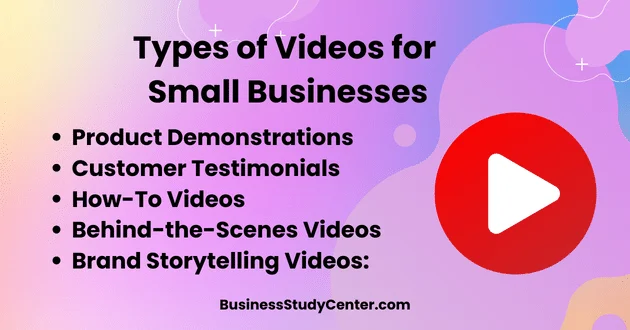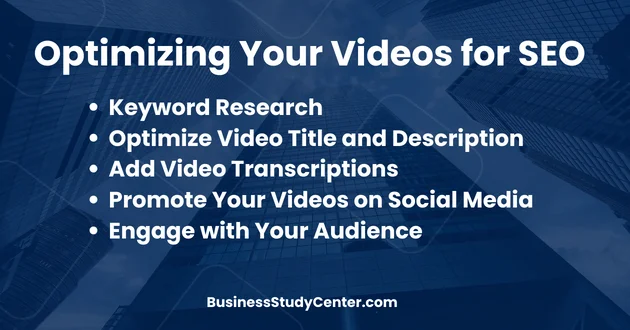
In today’s digital age, video marketing has become an essential tool for small businesses to reach their target audience and drive engagement. This comprehensive guide will take you through the process of creating and implementing an effective video marketing strategy for your small business. From understanding the benefits of video marketing to tips on creating compelling videos, this guide has everything you need to know to harness the power of video and take your small business to new heights.
Introduction to Video Marketing
Video marketing has emerged as a powerful tool for small businesses to connect with their target audience in a more engaging and memorable way. In this section, we will explore the benefits of video marketing and why it should be an integral part of your small business marketing strategy.
Video marketing allows businesses to showcase their products or services in a visually appealing and interactive format. It helps in building brand awareness, increasing website traffic, and driving conversions. According to a recent study, 85% of businesses reported that video marketing has led to an increase in their ROI.
Understanding Your Target Audience
Before diving into creating videos, it is crucial to understand your target audience. By knowing who your audience is, you can create videos that resonate with them and effectively communicate your message. In this section, we will discuss how to identify your target audience and tailor your videos to meet their needs.
Start by conducting market research to gather insights about your target audience’s demographics, interests, and preferences. This can be done through online surveys, social media analytics, or customer feedback. Once you have a clear understanding of your target audience, you can create videos that address their pain points and provide solutions.

Types of Videos for Small Businesses
There are various types of videos that small businesses can create to engage their audience and promote their products or services. In this section, we will explore some popular types of videos that are effective for small businesses.
- Product Demonstrations: Showcase how your product works and highlight its key features through product demonstration videos. This type of video helps potential customers understand the value and benefits of your product.
- Customer Testimonials: Build trust and credibility by featuring customer testimonials in your videos. Testimonial videos allow satisfied customers to share their positive experiences with your product or service.
- How-To Videos: Provide value to your audience by creating how-to videos that demonstrate how to use your product or solve common problems related to your industry. How-to videos position your business as an expert in the field and help establish your brand’s authority.
- Behind-the-Scenes Videos: Give your audience a glimpse into the behind-the-scenes workings of your business. This type of video helps humanize your brand and create a connection with your audience.
- Brand Storytelling Videos: Share the story behind your brand, its mission, and values through storytelling videos. This type of video helps create an emotional connection with your audience and builds brand loyalty.
Creating Engaging Videos
Now that you have an understanding of the types of videos you can create, it’s time to delve into the process of actually creating engaging videos. In this section, we will discuss some tips and best practices for creating compelling videos that captivate your audience.
- Plan Your Video: Before hitting the record button, plan out your video content. Define the purpose, key messages, and desired outcomes of your video. Create a storyboard or script to ensure a smooth flow and coherent message.
- Keep it Short and Concise: Attention spans are shorter than ever, so it’s essential to keep your videos short and concise. Aim for videos that are between 1-2 minutes long to maintain your audience’s attention.
- Use High-Quality Equipment: Invest in good quality equipment to ensure professional-looking videos. Use a high-resolution camera, good lighting, and clear audio equipment to enhance the overall quality of your videos.
- Tell a Compelling Story: Storytelling is a powerful tool in video marketing. Craft a compelling narrative that connects with your audience emotionally and keeps them engaged throughout the video.
- Incorporate Branding Elements: Consistency is key when it comes to branding. Incorporate your brand’s logo, colors, and messaging into your videos to reinforce your brand identity and build brand recognition.

Optimizing Your Videos for SEO
Creating great videos is only half the battle; you also need to ensure that they get discovered by your target audience. In this section, we will explore how to optimize your videos for SEO (search engine optimization) to improve their visibility on search engines like Google and YouTube.
- Keyword Research: Conduct keyword research to identify relevant keywords that are commonly used by your target audience when searching for content related to your industry. Incorporate these keywords in your video title, description, and tags.
- Optimize Video Title and Description: Craft a compelling video title that includes relevant keywords. Write a detailed description that provides context about the video content and includes relevant keywords naturally.
- Add Video Transcriptions: Including transcriptions or closed captions in your videos not only makes them more accessible but also helps search engines understand the content better. Transcriptions also provide an opportunity to add relevant keywords.
- Promote Your Videos on Social Media: Leverage the power of social media platforms to promote your videos and increase their visibility. Share your videos on platforms like Facebook, Instagram, Twitter, and LinkedIn to reach a wider audience.
- Engage with Your Audience: Encourage viewers to like, comment, and share your videos. Respond promptly to comments and engage with your audience to foster a sense of community around your videos.
Measuring Video Performance
To gauge the success of your video marketing efforts, it is essential to measure key performance metrics. In this section, we will discuss some metrics you should track to evaluate the effectiveness of your video marketing strategy.
- View Count: Monitor the number of views generated by each video to gauge its reach and popularity among your target audience.
- Engagement Metrics: Track metrics such as likes, comments, shares, and click-through rates (CTRs) to measure how well your videos are engaging viewers.
- Conversion Rates: If your goal is to drive conversions, track conversion rates by monitoring how many viewers take the desired action after watching the video (e.g., making a purchase or signing up for a newsletter).
- Audience Retention: Analyze audience retention metrics to understand at what point viewers drop off from watching your videos. This insight can help you identify areas for improvement in terms of content and video length.
- Social Media Metrics: If you promote your videos on social media platforms, track metrics such as reach, impressions, and engagement on each platform to measure their effectiveness.
Tips for Video Distribution
Creating great videos is only part of the equation; you also need to ensure that they reach your target audience effectively. In this section, we will discuss some tips for distributing your videos across various platforms.
- YouTube: As the second largest search engine after Google, YouTube is an excellent platform for hosting and sharing your videos. Optimize your YouTube channel with relevant keywords, engaging thumbnails, and a compelling channel description.
- Website Embedding: Embedding videos on your website improves user engagement and enhances SEO. Add videos to relevant website pages such as product pages or blog posts.
- Social Media Platforms: Share your videos on social media platforms like Facebook, Instagram, Twitter, and LinkedIn to reach a wider audience. Customize each platform’s video specs (e.g., aspect ratio) for optimal viewing experience.
- Email Marketing: Include video content in your email marketing campaigns to increase open rates and click-through rates. Use engaging thumbnails and compelling subject lines to encourage recipients to watch the video.
- Paid Advertising: Consider investing in paid advertising platforms like Google Ads or social media advertising (e.g., Facebook Ads) to extend the reach of your videos beyond organic channels.
Case Studies – Successful Video Marketing Campaigns
To provide inspiration and practical insights, this section will showcase some successful video marketing campaigns implemented by small businesses. These case studies will highlight the strategies, tactics, and results achieved by these businesses through their video marketing efforts.
Case Study 1: “The Handmade Soap Company”
Objective: Increase brand awareness and drive online sales
“The Handmade Soap Company” is a small business that specializes in crafting artisanal soaps and skincare products. To increase brand awareness and drive online sales, they implemented a video marketing campaign.
Strategy:
- Storytelling: They created a brand storytelling video that showcased the founders’ passion for creating natural and sustainable products. The video highlighted their commitment to quality ingredients and the production process.
- Product Demonstrations: They produced short videos demonstrating the benefits and usage of their different products. These videos showcased the products in action and provided viewers with a closer look at their unique features.
- Social Media Promotion: The videos were shared across social media platforms, targeting audiences interested in natural skincare, self-care, and sustainability. They also collaborated with relevant influencers who aligned with their brand values to reach a wider audience.
Results:
- Increased brand awareness: The brand storytelling video resonated with viewers, resulting in a significant increase in brand awareness and recognition.
- Boosted online sales: The product demonstration videos helped potential customers understand the value of their products, leading to a notable increase in online sales.
- Engaged audience: The videos garnered high engagement rates, with viewers leaving positive comments, sharing their own experiences, and tagging friends who might be interested in the products.
Case Study 2: “Fit & Fab Fitness Studio”
Objective: Drive membership sign-ups and increase class attendance
“Fit & Fab Fitness Studio” is a small business offering various fitness classes. They aimed to drive membership sign-ups and increase class attendance through their video marketing campaign.
Strategy:
- How-To Videos: They created short how-to videos that demonstrated different workout routines and exercises. These videos provided value to viewers by offering them fitness tips and guidance.
- Customer Testimonials: They filmed testimonials featuring satisfied members who had achieved their fitness goals through the studio’s classes. These videos showcased real success stories and built trust among potential customers.
- Behind-the-Scenes Videos: They shared behind-the-scenes footage of instructors preparing for classes, setting up equipment, and interacting with members. These videos humanized the brand, giving viewers a sense of the positive atmosphere and community within the fitness studio.
Results:
- Increased membership sign-ups: The combination of how-to videos showcasing workout routines and customer testimonials highlighting successful transformations led to a notable increase in membership sign-ups.
- Higher class attendance: The videos showcasing the behind-the-scenes aspects of the studio helped create anticipation and excitement among viewers, resulting in increased class attendance.
- Improved customer engagement: Viewers actively engaged with the videos by asking questions, seeking advice, and sharing their own fitness journeys in the comments section.
Conclusion
Video marketing has become an essential component of any small business’s marketing strategy due to its ability to engage audiences effectively and drive results. By following the tips outlined in this guide, small businesses can harness the power of video marketing to reach their target audience, increase brand awareness, drive engagement, and ultimately grow their business in today’s digital landscape.
Read more: Travel Marketing Strategies


